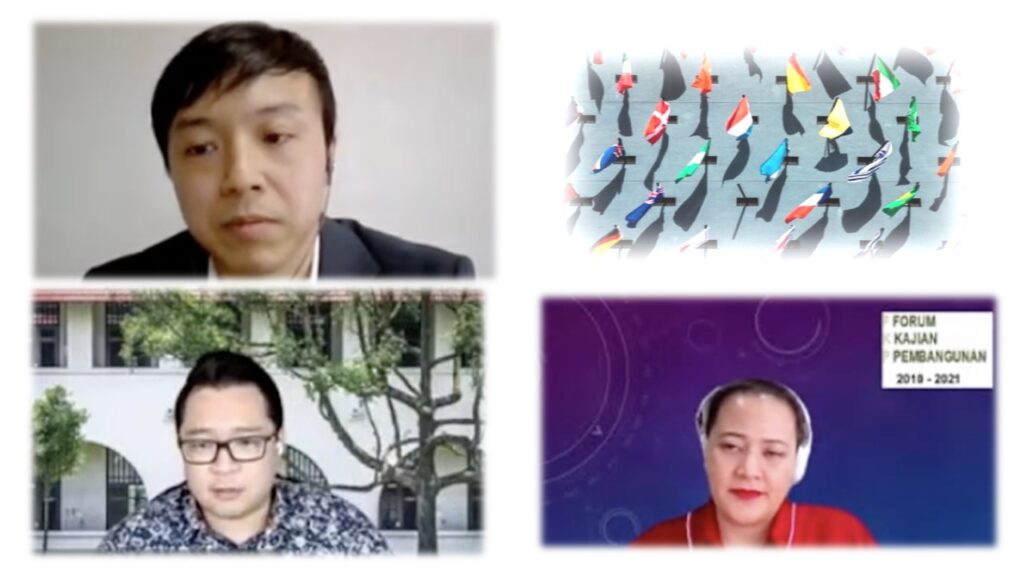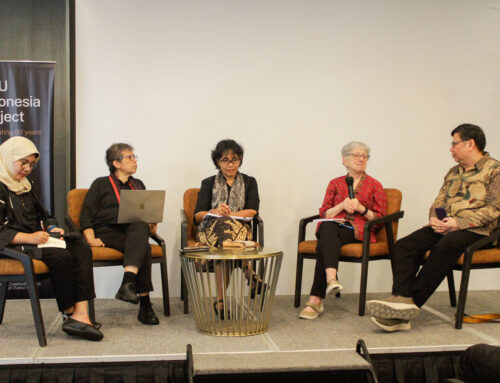FKP hosted by BAPPENAS with Arianto C. Hartono (BAPPENAS and International University of Japan), Astari Daenuwy (Ministry of Foreign Affairs), and Evan A. Laksmana (National University of Singapore). Thursday, 28 October 2021.
KEY POINTS:
- History records indications of polarization between the ASEAN Member States. History records conflicts and crises in the region, such as the East Asian economic crisis, and the ongoing South China Sea (SCS) dispute. Furthermore, ASEAN’s collective identity is still fragile, many ASEAN agreements in the past were not fully supported by all ASEAN members. Lastly, there are four main roles in Southeast Asia as part of the larger Asia-Pacific order: The US as guarantor of a large offshore power; China as a responsible regional great power; Japan as a regional economic great power; and ASEAN as a regional conductor.
- There are indications of polarization among the ASEAN member states towards China, Japan, and the U.S. (the nature of polarization is different at the regional level and the global level). Given the complexity of the rivalry (China-U.S.) and the dynamic of the polarization (China-Japan), the research supports the argument that the future regional order in ASEAN is still open between polarity, regionalism, or concert of power.
SUMMARY
- Recent regional studies have argued for geopolitical influence as one of the important determinants of regional order. However, so far the influence of geopolitics has only been measured qualitatively, while efforts on quantitative approaches often encounter robustness issues. One way to obtain robustness is through factor analysis, but its application is still limited to the number of years of observation, the area covered, and the countries included. Arianto Hartono (International University of Japan and BAPPENAS) is conducting a study that will further expand the quantitative analysis of geopolitical influence to assess its impact on the regional order of Southeast Asia. It will also provide a quantitative approach explaining the polarization in Southeast Asia to support the indications of existing studies/surveys.
- History records indications of polarization between the ASEAN Member States towards China and the US during conflicts or crises in the region. There are three main factors influencing ASEAN geopolitics and polarization. First, history records conflicts and crises in the region, such as the Vietnam War, the Cambodian conflict, the East Asian economic crisis, and the ongoing South China Sea (SCS) dispute. Second, ASEAN’s collective identity is still fragile. Many ASEAN agreements in the past (Declaration of ASEAN Concord, Treaty of Amity and Cooperation in Southeast Asia, etc.) were not fully supported by all ASEAN members, thus affecting the attitudes of countries towards the formation of ASEAN. Third, there are four main roles in Southeast Asia as part of the larger Asia-Pacific order: The US as guarantor of a large offshore power; China as a responsible regional great power; Japan as a regional economic great power; and ASEAN as a regional conductor.
- Looking at the dynamics between ASEAN, China, and the US, the geopolitical relations between them are influenced by the evolution of great power relations, such as the redefinition of China-America relations and the revision of the US-Japan alliance. The dominance of the US is mainly due to the geopolitical rivalry between China and Japan, as the second and third layers in the regional hierarchy. However, the dominant US influence has been challenged by China’s growing economic influence over the past few decades.
- This study shows that in the period 2005-2018, the US geopolitical influence in Southeast Asia has decreased, although it is still in a positive trend. US geopolitical influence tends to slow towards the end of a presidential administration. On the other hand, China’s rejuvenation has increased its geopolitical influence in Southeast Asia. Since 2006 China has started diplomatic forums with peripheral countries, they have also initiated many infrastructure projects such as Belt Road Initiatives and Asian Infrastructure and Investment Bank (AIIB). China was also the largest exporting destination and FDI in 2014. All of these efforts resulted in a significant increase in its geopolitical influence in ASEAN.
- China’s growing soft power (assertive foreign policy and public diplomacy) and hard power (infrastructure initiatives and military corporations) are helping to bring China closer to the center of regional dynamics. However, there is a fragile balance between China and Japan. Japan is losing its capacity to bring stability in the region. Therefore, the U.S existence in the region would play an important role in the region’s stability, at least until China proved itself reliable enough to play the main role. Compared to the U.S, Japan seems to be more welcomed in the region. The status of both China and Japan as the internal actors facilitate both countries to be more flexible and dynamic than the external actors such as the U.S.. Competition on secondary and third layers (China and Japan) is more dynamic than competition on first and secondary layers (China and the U.S.)
- How about the polarization and the future of Southeast Asia’s regional order? There are indications of polarization among the ASEAN member states towards China, Japan, and the U.S. (the nature of polarization is different at the regional level and the global level). Given the complexity of the rivalry (China-U.S.) and the dynamic of the polarization (China-Japan), the research supports the argument that the future regional order in ASEAN is still open between polarity, regionalism, or concert of power.
- Evan Laksmana from the National University of Singapore provided some notes on the topic. This study finds that over the past few decades there have been indications of polarization in Southeast Asian countries. Is polarization a good thing? Some argue it is good because no power dominates, others argue it is not good because we have to make choices, that one force is inherently better/worse than another. The policy implications of these findings remain unclear, so it is important to discuss the implications further. Also, there is a missing discussion about ASEAN as a group. This paper focuses more on ASEAN member states but not ASEAN as a group. The level of vulnerability and dependence of each Southeast Asian country does not necessarily imply strategic alignment at the level of ASEAN as a group.





